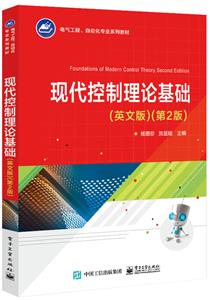-
>
闖進數學世界――探秘歷史名題
-
>
中醫基礎理論
-
>
當代中國政府與政治(新編21世紀公共管理系列教材)
-
>
高校軍事課教程
-
>
思想道德與法治(2021年版)
-
>
毛澤東思想和中國特色社會主義理論體系概論(2021年版)
-
>
中醫內科學·全國中醫藥行業高等教育“十四五”規劃教材
現代控制理論基礎(英文版)(第2版) 版權信息
- ISBN:9787121414039
- 條形碼:9787121414039 ; 978-7-121-41403-9
- 裝幀:一般膠版紙
- 冊數:暫無
- 重量:暫無
- 所屬分類:>>
現代控制理論基礎(英文版)(第2版) 本書特色
現代控制理論是控制類專業學生必須掌握的重要基礎理論。本書是編者在多年雙語教學實踐經驗基礎上,參考國外優秀教材,按照我國課程教學大綱的要求編寫的。 全書共分8章,主要內容包括狀態空間分析法、數學基礎知識、線性動態系統的狀態響應、線性系統的可控性和可觀性、李亞普若夫穩定性分析、線性系統的狀態綜合(狀態反饋、輸出反饋和狀態觀測器)和*優控制的基本方法。除第1章外,其余各章均編寫了多個實驗例題,同時還配有一定數量的練習題和思考題,幫助學生了解和掌握理論方法及其在工程實踐中的應用。 本書主要作為普通高等院校控制類專業本科生和非控制類專業(如電子類、機電類)研究生的教材和參考書,也可供廣大工程科技人員學習參考。
現代控制理論基礎(英文版)(第2版) 內容簡介
現代控制理論是控制類專業學生必須掌握的重要基礎理論。本書是編者在多年雙語教學實踐經驗基礎上,參考國外很好教材,按照我國課程教學大綱的要求編寫的。 全書分8章,主要內容包括狀態空間分析法、數學基礎知識、線性系統的狀態響應、線性系統的可控性和可觀性、李雅普若夫穩定性分析、線性系統的狀態綜合(狀態反饋、輸出反饋和狀態觀測器)和很優控制的基本方法。除章外,其余各章均編寫了多個應用型例題,同時還配有一定數量的練習題和思考題,幫助學生了解和掌握理論方法及其在工程實踐中的應用。 本書可作為普通高等院校控制類專業本科生和非控制類專業(如電子類、機電類)研究生的教材與參考書,也可供廣大工程科技人員學習參考。
現代控制理論基礎(英文版)(第2版) 目錄
1.1 Historical Review and Classical Control Theory
1.1.1 Historical Review of Automatic Control
1.1.2 Classical control theory
1.2 Modern Control Theory
1.3 Design of Control Systems
1.4 Outline of This Book
Chapter 2 Preliminary Mathematical Knowledge
2.1 Foundations of matrix algebra
2.1.1 Matrices
2.1.2 Algebraic operations with matrices
2.1.3 Matrix Operations
2.2 Vectors and Vector Spaces
2.2.1 Vector
2.2.2 Vector Spaces and Subspaces
2.3 Linear Algebra
2.3.1 Eigenvalue and Eigenvector of A Square Matrix
2.3.2 Linear Algebraic Equations
2.3.3 Similarity Transformation
2.3.4 Diagonal Form and Jordan Form
2.3.5 Cayley-Hamiton Theorem
2.3.6 Definiteness of A Scalar Function and Quadratic Form
Exercises
Chapter 3 State Variables and the State-Space Description of Dynamic Systems
3.1 State-Space Representation of Dynamic Systems
3.1.1 State and State Variables
3.1.2 State-Space Representation
3.1.3 Block Diagrams and Simulation Diagrams
3.2 Obtaining State Equations
3.2.1 From the Block Diagram
3.2.2 From Input-Output Representation
3.2.3 Equivalence Transformation of State-Space Representation
3.3 Transfer Function And Realizations
3.4 State-Space Representation of Linear Discrete-Time Systems
3.5 Summaries
Exercises
Problems
Chapter 4 Time Response of Linear Systems
4.1 Solution of LTI State Equations
4.1.1 Linear Homogeneous State Equations
4.1.2 The State Transition Matrix
4.1.3 Linear Nonhomogeous State Equations
4.2 Numerical Solution of State Equations
4.3 Solution of Linear Discrete-Time State Equations
4.4 Discretization of Continuous-Time Systems
Exercises
Problems
Chapter 5 Controllability and Observability
5.1 Corollaries of Cayley-Hamilton Theorem
5.2 Controllability and Observability of LTI Systems
5.2.1 Controllability Definition and Rank Criterion
5.2.2 Observability Definition and Rank Criterion
5.2.3 Controllable Canonical Form and Observable Canonical Form
5.2.4 Principle of Duality
5.3 Structural Decomposition of LTI systems
5.4 Controllability, Observability and Transfer Function
5.5 Controllability and Observability of Discrete-Time Systems
5.5.1 Controllability of Discrete-Time Systems
5.5.2 Observability of Discrete-Time Systems
5.5.3 Controllability and Observability After Sampling
Exercises
Problems
Chapter 6 Lyapunov Stability
6.1 Preliminary Examples
6.2 Stability Concepts
6.2.1 Equilibrium State
6.2.2 Stability Definitions
6.3 First Method of Lyapunov
6.3.1 Eigenvalue Criterion for Linear Time-invariant System
6.3.2 Eigenvalue Criterion for Linearized Time-invariant Systems
6.4 Second Method of Lyapunov
6.5 Lyapunov Equation
Exercise
Problems
Chapter 7 State Feedback and State Observer
7.1 State Feedback and Output Feedback
7.1.1 State Feedback
7.1.2 Output Feedback
7.2 Pole Placement using State feedback
7.3 Pole placement using Output Feedback
7.4 State Observer
7.4.1 Full-Dimensional Observer
7.4.2 Reduced-Dimensional State Observer
7.5 Feedback From Estimated States
7.6 The Engineering Applications of State Feedback and Observer
7.6.1 State Feedback Controller Design For The Inverted Pendulum
7.6.2 Asymptotic Tracking And Disturbance Rejection
7.6.3 System Stabilization
7.6.4 System Decoupling
Exercises
Problems
Chapter 8 Optimal Control
8.1 Problem Formulation
8.2 Preliminaries:The extremum problem of functional
8.2.1 Functional and The Calculus of Variation
8.2.2 The Extremum Problem of Functional Without Constraints
8.3 The Variational Approach to Optimal Control Problems
8.4 Minimum Principle and Its Application
8.4.1 Pontryagin's Minimum Principle
8.4.2 Application of Minimum Principle
Exercises
Problems
Answers to Selected Exercises
Experiment 1: Modeling and Stability Analysis of the Inverted Pendulum System
Experiment 2: Design State Feedback Controller for the Inverted Pendulum System
Bibliography
現代控制理論基礎(英文版)(第2版) 作者簡介
楊慧珍,博士,副教授。1978年3月參加工作。1991/8–1995/7,西北工業大學,工業自動化,學士;1995/9–1998/3,西北工業大學,水中兵器,碩士;2000/9–2005/5, 西北工業大學, 武器系統與運用工程,博士;1998/4-至今,西北工業大學,航海學院,教師;2008/12-2009/12,美國佐治亞理工學院,電子與計算機工程系,訪問學者。參加的學術組織及任職:中國仿真學會,理事。個人及集體榮譽:2014年,西北工業大學"最滿意教師”稱號;2013年陜西省精品課程"魚雷自動控制系統”重要成員。所承的科研項目:主持省部級基金項目3項,參與軍科委,國家自然科學基金委等國家級項目2項;西北工業大學《現代控制理論基礎》全英文教學課程建設項目;西北工業大學《現代控制理論基礎》教學與考核模式改革項目;西北工業大學《現代控制理論基礎》課程思政建設項目; 楊惠珍,牛津大學EMI全英文教學培訓的啟示與實踐,高教學刊,2020.5。教學成果獲獎情況:**導航控制一體化仿真系統及關鍵技術,國防科學技術進步獎二等獎,2011年,排名第2;**雷控制系統,國防科學技術進步獎二等獎,2009年,排名第7;**分布交互及海洋戰場視景仿真技術,國防科學技術獎二等獎,2006年,排名第3。出版著作情況:楊惠珍,賀昱曜,Foundation of Modern Control Theory/現代控制理論基礎,西北工業大學出版社,2016.1.1;康鳳舉,楊惠珍,高立娥,現代仿真技術與應用(第2版),國防工業出版社,2006.1.1(教育部遴選的全國研究生推薦教材。);吳旭光,楊惠珍,王新民,計算機仿真技術(第二版),化學工業出版社,2008.9.1(化學工業部優秀教材二等獎,普通高等教育"十一五”國家級規劃教材)。
- >
伊索寓言-世界文學名著典藏-全譯本
- >
回憶愛瑪儂
- >
姑媽的寶刀
- >
巴金-再思錄
- >
苦雨齋序跋文-周作人自編集
- >
有舍有得是人生
- >
唐代進士錄
- >
中國人在烏蘇里邊疆區:歷史與人類學概述
















